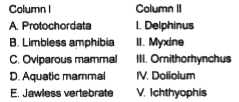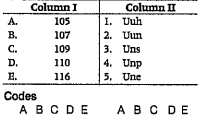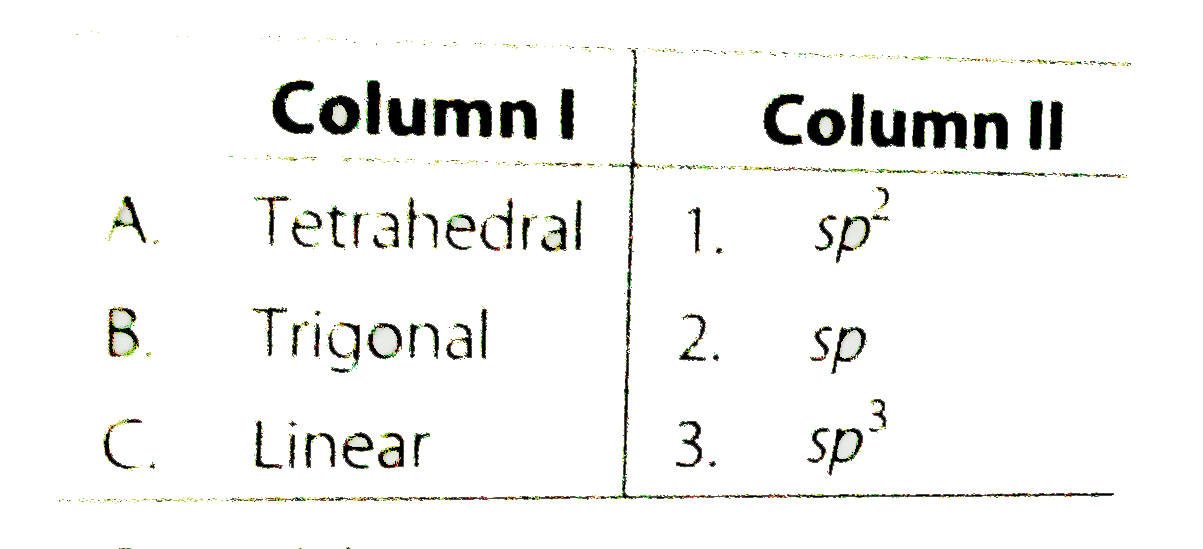Match the items in Column I with relevant items in Column II
To solve the matching question, we will analyze each item in Column I and find the corresponding item in Column II.
1. (i) Ions having positive charge:
- Ions with a positive charge are known as Cations.
- Match: (i) → (e) Cation
2. (ii) The sum of oxidation number of all atoms in a neutral molecule:
- In a neutral molecule, the sum of oxidation numbers is always 0.
- Match: (ii) → (d) 0
3. (iii) Oxidation number of hydrogen ion (H⁺):
- The oxidation number of a hydrogen ion (H⁺) is +1.
- Match: (iii) → (c) +1
4. (iv) Oxidation number of fluorine in NaF:
- In sodium fluoride (NaF), sodium (Na) has an oxidation state of +1, thus the oxidation number of fluorine (F) must be -1 to balance the charge in the neutral compound.
- Match: (iv) → (b) -1
5. (v) Ions having negative charge:
- Ions with a negative charge are known as Anions.
- Match: (v) → (f) Anion
Final Matches:
- (i) → (e) Cation
- (ii) → (d) 0
- (iii) → (c) +1
- (iv) → (b) -1
- (v) → (f) Anion
- Ions with a positive charge are known as Cations.
- Match: (i) → (e) Cation
- In a neutral molecule, the sum of oxidation numbers is always 0.
- Match: (ii) → (d) 0
- The oxidation number of a hydrogen ion (H⁺) is +1.
- Match: (iii) → (c) +1
- In sodium fluoride (NaF), sodium (Na) has an oxidation state of +1, thus the oxidation number of fluorine (F) must be -1 to balance the charge in the neutral compound.
- Match: (iv) → (b) -1
- Ions with a negative charge are known as Anions.
- Match: (v) → (f) Anion
- (i) → (e) Cation
- (ii) → (d) 0
- (iii) → (c) +1
- (iv) → (b) -1
- (v) → (f) Anion
Topper's Solved these Questions
- BOOK - MODERN PUBLICATIONCHAPTER - REDOX REACTIONS EXERCISE - NCERT FILE Solved (NCERT - Exemplar Problems) (Assertion and Reason Type Questions)4videos
REDOX REACTIONS
- BOOK - MODERN PUBLICATIONCHAPTER - REDOX REACTIONS EXERCISE - NCERT FILE Solved (NCERT - Exemplar Problems) (Long Answer Questions )6videos
REDOX REACTIONS
- BOOK - MODERN PUBLICATIONCHAPTER - REDOX REACTIONS EXERCISE - NCERT FILE Solved (NCERT - Exemplar Problems) (Short Answer Questions)10videos
REDOX REACTIONS
- BOOK - MODERN PUBLICATIONCHAPTER - ORGANIC CHEMISTRY: BASIC PRINCIPLES AND TECHNIQUESEXERCISE - (Competition File) MULTIPLE CHOICE QUESTIONS ( based on the given. passage/comprehension )8videos
ORGANIC CHEMISTRY: BASIC PRINCIPLES AND TECHNIQUES
- BOOK - MODERN PUBLICATIONCHAPTER - S-BLOCK ELEMENTS ( ALKALI AND ALKALINE EARTH METALS ) EXERCISE - UNIT PRACTICE TEST13videos
S-BLOCK ELEMENTS ( ALKALI AND ALKALINE EARTH METALS )
Similar Questions
Match the items in Column I with relevant items in Column II
Column IColumn II(i) Ions having positive charge(a)+7(ii) The sum of oxidation number of (b)−1 all atoms in a neutral molecule(iii) Oxidation number of hydrogen (c)+1 ion(H+)(iv) Oxidation number of fluorine in (d)0 NaF(v) Ions having negative charge (e) Cation(f) AnionView SolutionMatch the items in Column I with relevant items in Column II
Column IColumn II(i) Ions having positive charge(a)+7(ii) The sum of oxidation number of (b)−1 all atoms in a neutral molecule(iii) Oxidation number of hydrogen (c)+1 ion(H+)(iv) Oxidation number of fluorine in (d)0 NaF(v) Ions having negative charge (e) Cation(f) AnionView Solution
Knowledge Check
- Question 1 - Select One
Match item in column I with those given in column II. Column 1
 AA-V, B-IV, C-III, D-I, E-IIBA-IV, B-V, C-II, D-I, E-IICA-IV, B-V, C-III, D-II, E-IDA-V, B-III, C-I, D-II, E-IV
AA-V, B-IV, C-III, D-I, E-IIBA-IV, B-V, C-II, D-I, E-IICA-IV, B-V, C-III, D-II, E-IDA-V, B-III, C-I, D-II, E-IV - Question 2 - Select One
Match the items in Column I with its main use listed in Column II:
Column I Column II(A) Silica gel(i) Transistor(B) Silicon(ii) Ion-exchanger(C) Silicone(iii) Drying agent(D) Silicate(iv) SealantA(A)-(iii),(B)-(i),(C )-(iv),(D)-(ii)B(A)-(iv),(B)-(i),(C )-(ii),(D)-(iii)C(A)-(ii),(B)-(i),(C )-(iv),(D)-(iii)D(A)-(ii),(B)-(iv),(C )-(i),(D)-(iii)
Match the atomic number in column I with its IUPAC nomenclature in column II
 View Solution
View SolutionMatch the half reaction in column I with change in oxidation number in column II
 View Solution
View SolutionMatch the items given in Column I with examples given in Column II.
 View Solution
View SolutionMatch the items given in Column 1 with examples give in Column II.
Column IColumn II(a)Hydrogen bond(i)C(b)Resonance(ii)LiF(c)Ionic solid(iii)H2(d)Covalent solid(iv)HF(v)O3View SolutionMatch the shape of molecules in Column I with the type of hybridisation in Column II.
 View Solution
View SolutionMatch the items given in column I with appropriate items (o ne or more) of column II :
Column I Column II(i) m- RNA (a) UAA(ii) Initition condon (b) Beadle and Tatum(iii) Termination codon(c) AUG(iv) Anticodon(d) Hetergoeneous nuclear RNA (hn RNA)(v) One gene one enzyme hypothesis(e) GUG(vi) Semiconservative mode of DNA replication(f) UAG(g) t-RNA(h) Meselson and StahlView Solution

